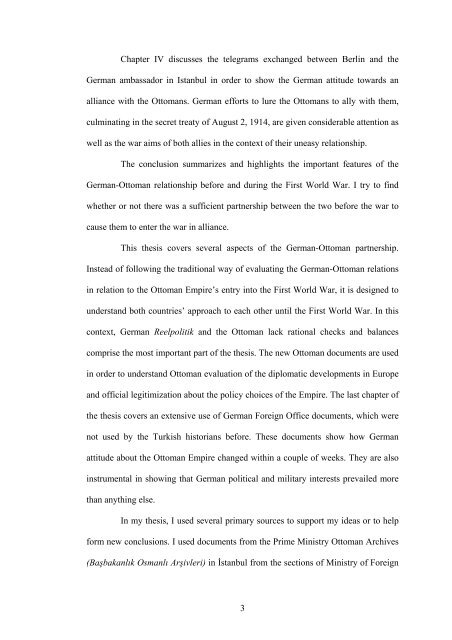the beginnings of ottoman-german partnership - Bilkent University
the beginnings of ottoman-german partnership - Bilkent University
the beginnings of ottoman-german partnership - Bilkent University
You also want an ePaper? Increase the reach of your titles
YUMPU automatically turns print PDFs into web optimized ePapers that Google loves.
Chapter IV discusses <strong>the</strong> telegrams exchanged between Berlin and <strong>the</strong><br />
German ambassador in Istanbul in order to show <strong>the</strong> German attitude towards an<br />
alliance with <strong>the</strong> Ottomans. German efforts to lure <strong>the</strong> Ottomans to ally with <strong>the</strong>m,<br />
culminating in <strong>the</strong> secret treaty <strong>of</strong> August 2, 1914, are given considerable attention as<br />
well as <strong>the</strong> war aims <strong>of</strong> both allies in <strong>the</strong> context <strong>of</strong> <strong>the</strong>ir uneasy relationship.<br />
The conclusion summarizes and highlights <strong>the</strong> important features <strong>of</strong> <strong>the</strong><br />
German-Ottoman relationship before and during <strong>the</strong> First World War. I try to find<br />
whe<strong>the</strong>r or not <strong>the</strong>re was a sufficient <strong>partnership</strong> between <strong>the</strong> two before <strong>the</strong> war to<br />
cause <strong>the</strong>m to enter <strong>the</strong> war in alliance.<br />
This <strong>the</strong>sis covers several aspects <strong>of</strong> <strong>the</strong> German-Ottoman <strong>partnership</strong>.<br />
Instead <strong>of</strong> following <strong>the</strong> traditional way <strong>of</strong> evaluating <strong>the</strong> German-Ottoman relations<br />
in relation to <strong>the</strong> Ottoman Empire’s entry into <strong>the</strong> First World War, it is designed to<br />
understand both countries’ approach to each o<strong>the</strong>r until <strong>the</strong> First World War. In this<br />
context, German Reelpolitik and <strong>the</strong> Ottoman lack rational checks and balances<br />
comprise <strong>the</strong> most important part <strong>of</strong> <strong>the</strong> <strong>the</strong>sis. The new Ottoman documents are used<br />
in order to understand Ottoman evaluation <strong>of</strong> <strong>the</strong> diplomatic developments in Europe<br />
and <strong>of</strong>ficial legitimization about <strong>the</strong> policy choices <strong>of</strong> <strong>the</strong> Empire. The last chapter <strong>of</strong><br />
<strong>the</strong> <strong>the</strong>sis covers an extensive use <strong>of</strong> German Foreign Office documents, which were<br />
not used by <strong>the</strong> Turkish historians before. These documents show how German<br />
attitude about <strong>the</strong> Ottoman Empire changed within a couple <strong>of</strong> weeks. They are also<br />
instrumental in showing that German political and military interests prevailed more<br />
than anything else.<br />
In my <strong>the</strong>sis, I used several primary sources to support my ideas or to help<br />
form new conclusions. I used documents from <strong>the</strong> Prime Ministry Ottoman Archives<br />
(Başbakanlık Osmanlı Arşivleri) in İstanbul from <strong>the</strong> sections <strong>of</strong> Ministry <strong>of</strong> Foreign<br />
3
















